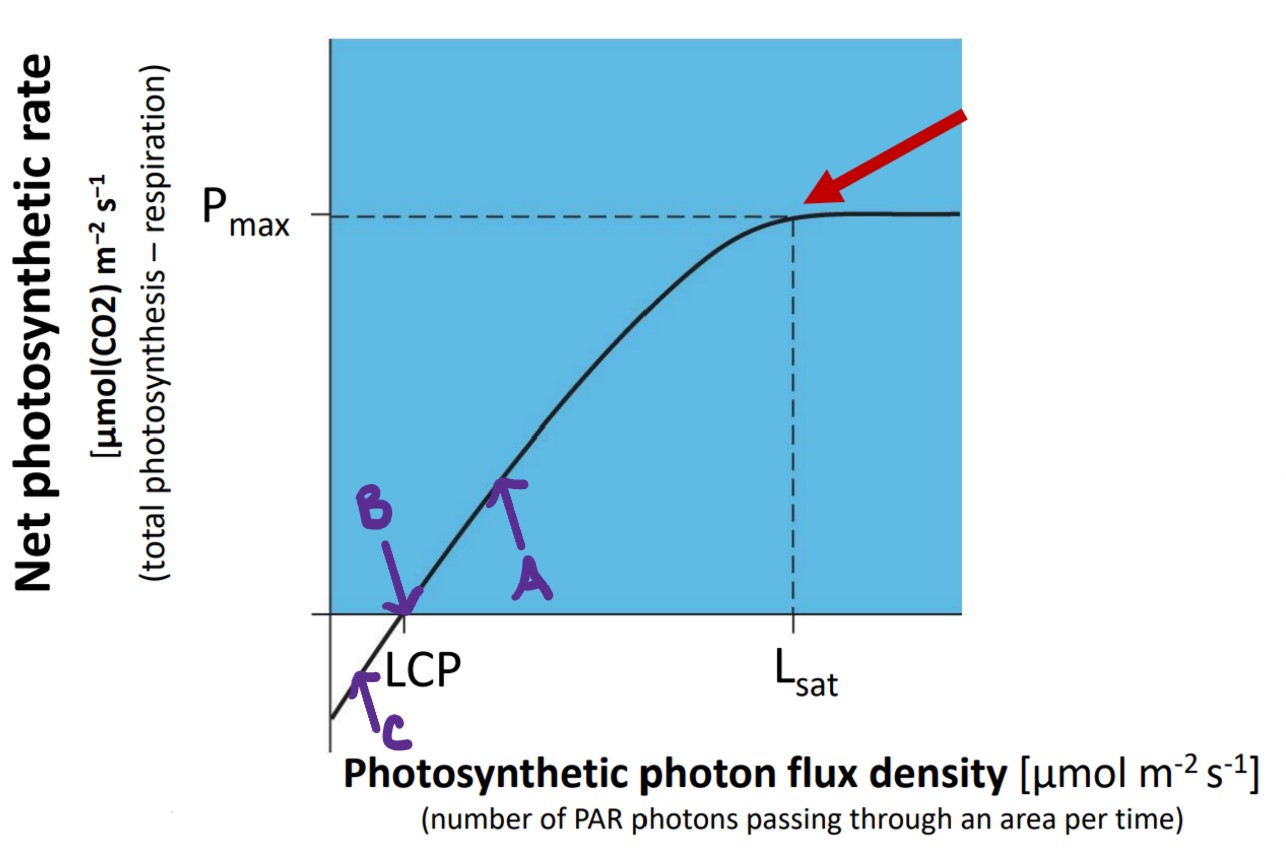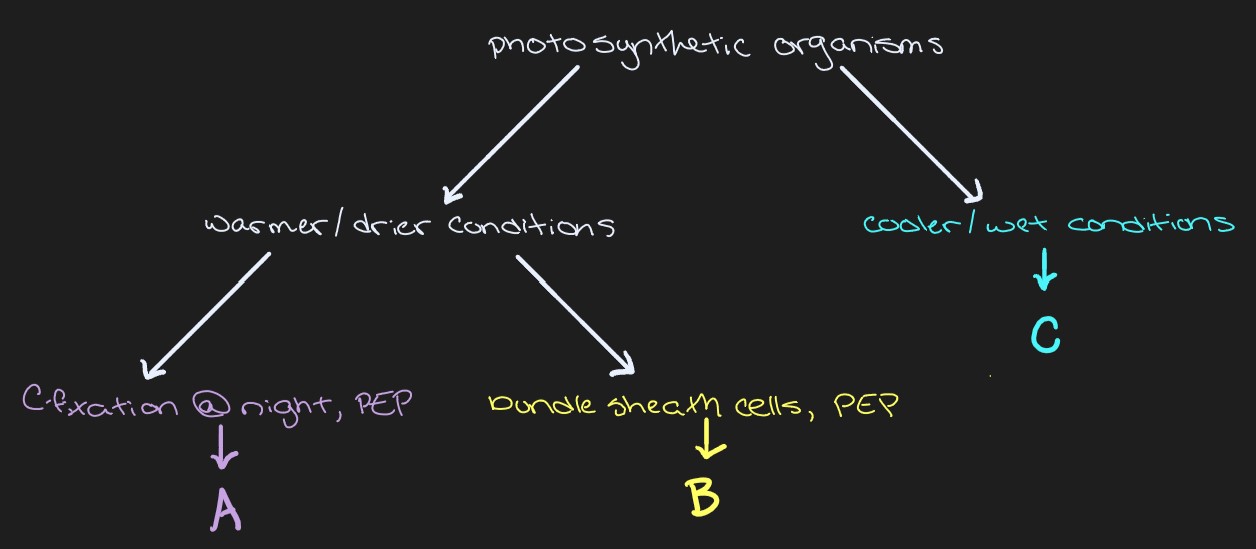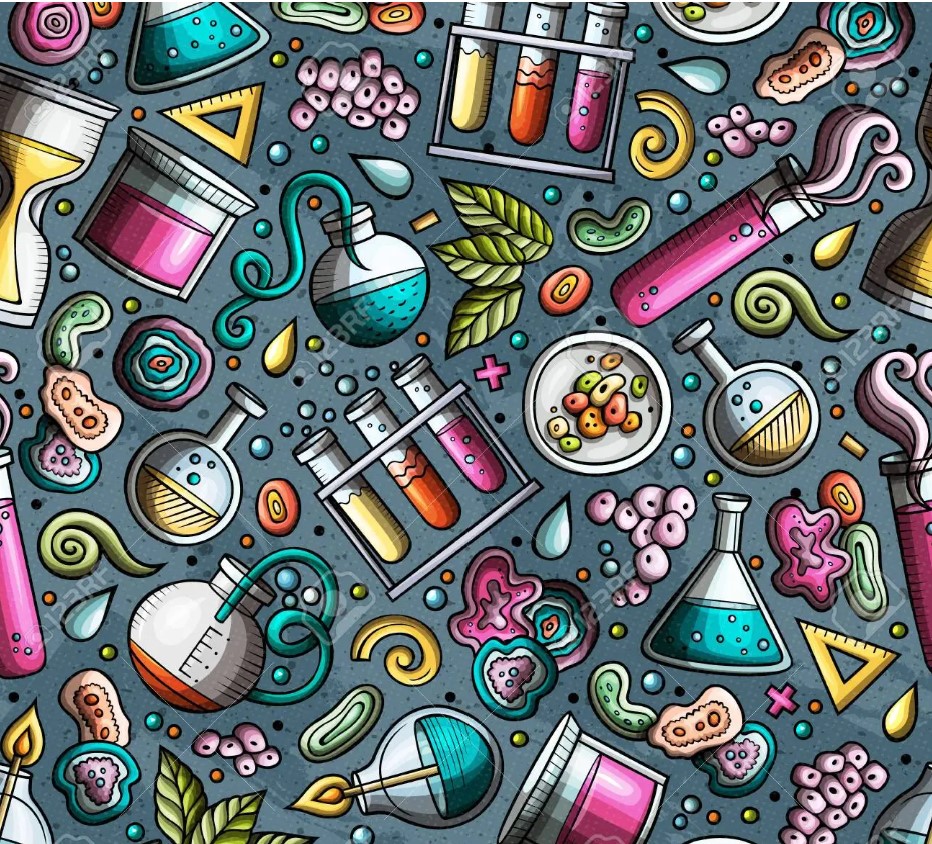09. Autotrophs & Energy
0.0(0)
Card Sorting
1/31
Earn XP
Study Analytics
Name | Mastery | Learn | Test | Matching | Spaced |
|---|
No study sessions yet.
32 Terms
1
New cards
Autotrophy vs Heterotrophy
^^Autotrophy^^ → make their **own complex carbohydrates** for nourishments from **inorganic** carbon sources
^^Heterotrophy^^ → use **organic** sources of **carbon** synthesized by others to derive E (consumer other organisms)
^^Heterotrophy^^ → use **organic** sources of **carbon** synthesized by others to derive E (consumer other organisms)
2
New cards
Photosynthesis vs Chemosynthesis
^^Photosynthesis^^ → converts **CO2** to complex sugars → derives energy from **light**
^^Chemosynthesis^^ → converts **CO2** (or methane) to complex sugars → derives energy from **oxidation**
\*similar but diff E sources
^^Chemosynthesis^^ → converts **CO2** (or methane) to complex sugars → derives energy from **oxidation**
\*similar but diff E sources
3
New cards
What is light?
**Electromagnetic radiation**
4
New cards
Wave-Particle Duality
Radiation behaves as both a **wave** & **particle** (photon = light particle)
Electromagnetic radiation can be described as **wavelength** & **photon E**
Electromagnetic radiation can be described as **wavelength** & **photon E**
5
New cards
Relationship B/w Wavelength & Energy
**Longer** wavelengths → **less** energy
**Shorter** wavelengths → **more** energy
Can have too much & not enough E for photosynthesis
**Shorter** wavelengths → **more** energy
Can have too much & not enough E for photosynthesis
6
New cards
Define: PAR
PAR → __**P**__**hotosynthetically** __**A**__**ctive** __**R**__**adiation**
Consists of visible light → \~400-700nm (purple-red) → can be used to **photosynthesize**
Subject to conditions → ex. shade, water depth, etc.
Consists of visible light → \~400-700nm (purple-red) → can be used to **photosynthesize**
Subject to conditions → ex. shade, water depth, etc.
7
New cards
PAR Availability in a Forest Environment
(3)
(3)
**Top** → **more PAR** more light b/c less blocking it
As you go **further down** → **lower** PAR availability
Organisms **adapt** to exposure to **more/less PAR**
As you go **further down** → **lower** PAR availability
Organisms **adapt** to exposure to **more/less PAR**
8
New cards
PAR in Water:
\
\--A-- light abs by autotrophs near surfaces emitting --B--
\
\--C-- light abs by autotrophs at great depths emitting --D-- but organisms must be --E-- to use this light range
\
\--A-- light abs by autotrophs near surfaces emitting --B--
\
\--C-- light abs by autotrophs at great depths emitting --D-- but organisms must be --E-- to use this light range
A → **red**
B → **green**
\
C → **blue**
D → **red** (chlorophyll abs green & blue → reflects red)
E → **adapted**
B → **green**
\
C → **blue**
D → **red** (chlorophyll abs green & blue → reflects red)
E → **adapted**
9
New cards
Three PAR Zones in Aquatic Systems
^^**Eu**photic (sunlight) zone^^ → sunlight penetrates this layer → only zone w **photosynthesis**
\
^^**Dys**photic (twilight) zone^^ → sunlight dec rapidly w depth → **no photosynthesis** possible here b/c not enough E for it
\
^^**A**photic (midnight) zone^^ → sunlight does not penetrate at all → zone in **entirely dark**
\
^^**Dys**photic (twilight) zone^^ → sunlight dec rapidly w depth → **no photosynthesis** possible here b/c not enough E for it
\
^^**A**photic (midnight) zone^^ → sunlight does not penetrate at all → zone in **entirely dark**
10
New cards
Photosynthetic Response Curves
Displays **energy limitation** in plants
Photosynthetic rates will **inc.** w inc. light (photon flux density) up **until** a **certain point**
Photosynthetic rates will **inc.** w inc. light (photon flux density) up **until** a **certain point**
11
New cards

Define: Lsat, Pmax, & LCP
\
Determine A, B, & C in terms respiration relative to photosynthesis
\
Determine A, B, & C in terms respiration relative to photosynthesis
^^Lsat^^ → irradiance at saturation → **light saturation point**
^^Pmax^^ → **max net photosynthesis**
^^LCP^^ → light compensation point → light intensity where **photosynthesis = respiration** → if more light is available, produces more sugars than it uses
\
A → respiration < photosynthesis
B → respiration = photosynthesis
C → respiration > photosynthesis
^^Pmax^^ → **max net photosynthesis**
^^LCP^^ → light compensation point → light intensity where **photosynthesis = respiration** → if more light is available, produces more sugars than it uses
\
A → respiration < photosynthesis
B → respiration = photosynthesis
C → respiration > photosynthesis
12
New cards

Response Curves Within a Species
\
Open vs Shade: Pmax & Lsat
\
Open vs Shade: Pmax & Lsat
Can depend on location
^^Open^^ → higher Pmax & Lsat
^^Shade^^ → lower Pmax & Lsat (more efficient at using E)
^^Open^^ → higher Pmax & Lsat
^^Shade^^ → lower Pmax & Lsat (more efficient at using E)
13
New cards
Sun Plants Response Curves
(2)
(2)
Achieve **higher Pmax**
but are **inefficient** in using **low PPFD** (fewer photons) → bad dealing w sudden low levels of light
but are **inefficient** in using **low PPFD** (fewer photons) → bad dealing w sudden low levels of light
14
New cards
Shade Plants Response Curves
(3)
(3)
Achieve only **small Pmax**
but **more efficient** at using **low PPFD** (fewer photons)
**Low Lsat** → can be damage in sunny sites/suddenly exposed to too much light
Higher photosynthetic rates
but **more efficient** at using **low PPFD** (fewer photons)
**Low Lsat** → can be damage in sunny sites/suddenly exposed to too much light
Higher photosynthetic rates
15
New cards
Basic Chemical Reaction of Photosynthesis
\
(+ origin/use of compounds)
\
(+ origin/use of compounds)
^^**6 CO2 + 6 H2O → C6H12O6 + 6 O2**^^
\
**CO2** → enter through **stomata** in the leaves (via diffusion)
**H2O** → enter through **water transportation**
**Glucose** → used to **gain E** via respiration
**O2** → a **byproduct** that is essential for many organisms
\
**CO2** → enter through **stomata** in the leaves (via diffusion)
**H2O** → enter through **water transportation**
**Glucose** → used to **gain E** via respiration
**O2** → a **byproduct** that is essential for many organisms
16
New cards
C3 Photosynthesis:
\
Time & Place
\
Time & Place
**No** anatomic/time **separation** of processes
\
^^Initial C fixation^^ → **mesophyll** (day)
^^Calvin cycle^^ → **mesophyll** (day)
\
^^Initial C fixation^^ → **mesophyll** (day)
^^Calvin cycle^^ → **mesophyll** (day)
17
New cards
C3 Photosynthesis:
Process (2)
Process (2)
**CO2** combines w **RuBP** (5C) catalyzed by **RUBISCO** enzyme
Produces **2 PGA** molecules (3C acids)
Produces **2 PGA** molecules (3C acids)
18
New cards
Issues w C3 Photosynthesis in Hot Climates
(3)
(3)
1. **RUBISCO** is **inefficient** at high temps
2. **Opening stomata** wastes water → **water loss possible** but is the only wat to get CO2 in & O2 out
3. **Closed stomata** → O2 inc. **suppressing photosynthesis**
19
New cards
C4 Photosynthesis:
Time & Place & How Accounts for Heat Dilemma
Time & Place & How Accounts for Heat Dilemma
**Anatomic separation** of processes
Adaption → allows it to **open** stomata **less** often
\
^^Initial C fixation^^ → **mesophyll** (day) → O2 can accumulate here
^^Calvin cycle^^ → **bundle sheath cells** (day) → can keep stoma closed
Adaption → allows it to **open** stomata **less** often
\
^^Initial C fixation^^ → **mesophyll** (day) → O2 can accumulate here
^^Calvin cycle^^ → **bundle sheath cells** (day) → can keep stoma closed
20
New cards
C4 Photosynthesis:
Process
Process
^^Mesophyll cells^^ → **CO2** combines w **PEP** (3C) catalyzed by **PEP carboxylase** → produces a **4C acid**
4C acids produces in the mesophyll diffuse to bundle sheath
^^Bundle sheath cells^^ → **4C acids** broken down into **3C acid** & **CO2**
Then enters the Calvin cycle (like C3 photosynthesis)
4C acids produces in the mesophyll diffuse to bundle sheath
^^Bundle sheath cells^^ → **4C acids** broken down into **3C acid** & **CO2**
Then enters the Calvin cycle (like C3 photosynthesis)
21
New cards
How does C4 Photosynthesis Process Increase Water Efficiency?
(2)
(2)
PEP carboxylase → high affinity for CO2 → can **reduce internal [CO2]** to very low → **inc. CO2 gradient** → inc. rate of CO2 diffusion inward → ^^need to open stomata less to get enough CO2^^
\
Removing RUBISCO from the high O2 area → can’t bind O2 (b/c in high \[CO2\] area) which leads to release of CO2
\
Removing RUBISCO from the high O2 area → can’t bind O2 (b/c in high \[CO2\] area) which leads to release of CO2
22
New cards
Why are there more C3 than C4 Photosynthesis Plants in Edmonton
^^C4 pathway^^ → **more H2O efficient** → not as much of a limiting factor here
^^C3 pathway^^ → **more E efficient** → evolutionarily more advantageous at this latitude
^^C3 pathway^^ → **more E efficient** → evolutionarily more advantageous at this latitude
23
New cards
CAM Photosynthesis:
Time & Place & How Accounts for Heat Dilemma
Time & Place & How Accounts for Heat Dilemma
**Time separation** of processes
Adaption → **open** stomata at **times** they are **less likely** to **lose** water
\
^^Initial C fixation^^ → **mesophyll** (night) → open stomata & fix
^^Calvin cycle^^ → **mesophyll** (day) → close stomata & complete
Adaption → **open** stomata at **times** they are **less likely** to **lose** water
\
^^Initial C fixation^^ → **mesophyll** (night) → open stomata & fix
^^Calvin cycle^^ → **mesophyll** (day) → close stomata & complete
24
New cards
CAM Photosynthesis:
Process
Process
^^Night^^ → combine **CO2** w **PEP** (3C) → produce a **4C acid** → acids **stored** until daylight
^^Day^^ → **4C acids** broken into **CO2** & **pyruvate** (3C) → then enters **C3 pathway** (Calvin cycle)
^^Day^^ → **4C acids** broken into **CO2** & **pyruvate** (3C) → then enters **C3 pathway** (Calvin cycle)
25
New cards
How does CAM Photosynthesis Process Increase Water Efficiency?
Open stomata at night → **lower temps** & **higher humidity** → ^^reduce water loss during CO2 uptake^^
26
New cards

Label the Photosynthetic Process
A → **CAM**
B → **C4**
C → **C3**
B → **C4**
C → **C3**
27
New cards
Chemoautotrophs thrive on nutrients from --A-- & often live in regions where --B--
A → **Hydrothermal vent** (deep sea)
Bacteria can **oxidize** these nutrient compounds → combine w carbon & undergo **chemosynthesis**
B → the **light doesn’t reach**
Bacteria can **oxidize** these nutrient compounds → combine w carbon & undergo **chemosynthesis**
B → the **light doesn’t reach**
28
New cards
What are hydrothermal vents?
What do they release?
What do they release?
**Fissures** in the **sea floor** (along oceanic rifts) → release **H2S** & **heat**
29
New cards
What are the primary producers in chemosynthetic environments?
Often **chemoautotrophic bacteria** act as primary producers support rich life
30
New cards
Chemo**litho**autotroph vs Chemo**organo**autotroph
^^Chemo**litho**autotroph^^ → derives E from **oxidizing** compounds of **inorganic** origin (eg. H2S, Fe2+, NH3, NH4+)
^^Chemo**organo**autotroph^^ → derives E from **oxidizing** compounds of **organic** origin (eg. CH4, etc.)
^^Chemo**organo**autotroph^^ → derives E from **oxidizing** compounds of **organic** origin (eg. CH4, etc.)
31
New cards
What is the chemosynthesis reaction?
**2 H2S + O2 → 2 S0 + 2 H2O + Energy**
H2S → from vents → bonds rich in E
S0 → elemental sulfur
Energy → used to synthesize organic molecules using CO2 as C source
H2S → from vents → bonds rich in E
S0 → elemental sulfur
Energy → used to synthesize organic molecules using CO2 as C source
32
New cards

